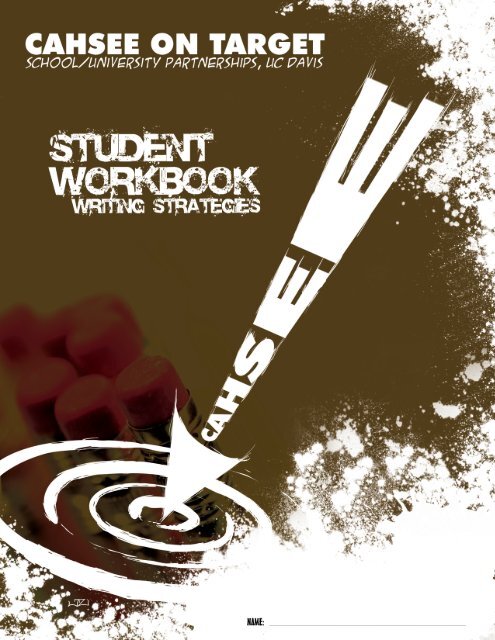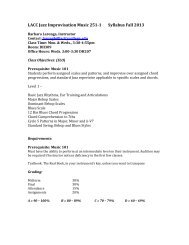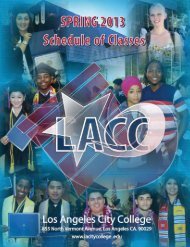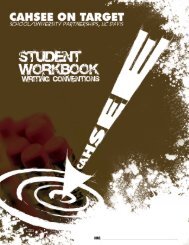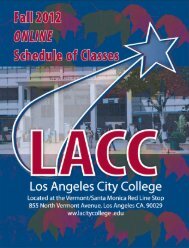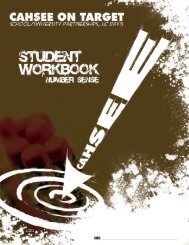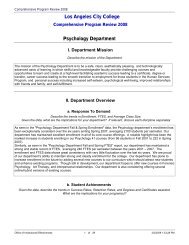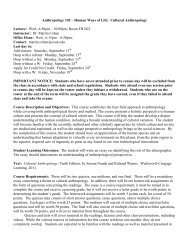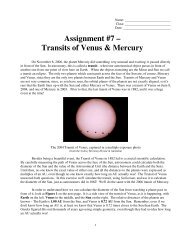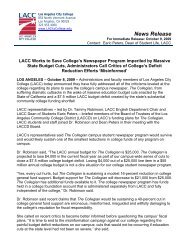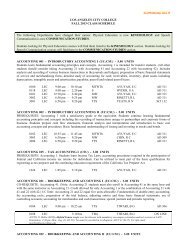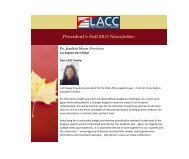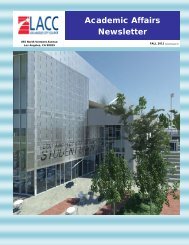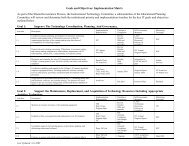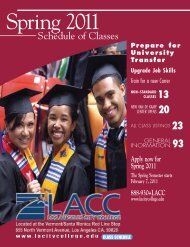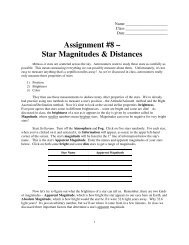Writing Strategies
Writing Strategies
Writing Strategies
Create successful ePaper yourself
Turn your PDF publications into a flip-book with our unique Google optimized e-Paper software.
CAHSEE on Target<br />
UC Davis, School and University Partnerships<br />
CAHSEE on Target<br />
English Language Arts Curriculum<br />
Published by<br />
The University of California, Davis,<br />
School/University Partnerships Program<br />
2006<br />
Director<br />
Sarah R. Martinez, School/University Partnerships, UC Davis<br />
Developed and Written by<br />
Syma Solovitch, School/University Partnerships, UC Davis<br />
Reviewers<br />
Jennifer Osborne, UC Davis English Graduate<br />
Faith Paul, School/University Partnerships, UC Davis<br />
Linda Whent, School/University Partnerships, UC Davis<br />
Sarah Rees, School/University Partnerships, UC Davis<br />
Design and Layout<br />
Bo Botelli, Publications Coordinator<br />
Jack Zhang, Publications Assistant<br />
Advising Services, UC Davis<br />
The CAHSEE on Target curriculum was made possible by<br />
funding and support from the California Academic Partnership Program,<br />
GEAR UP, and the University of California Office of the President.<br />
We also gratefully acknowledge the contributions of those teachers<br />
and administrators at Sacramento High School and Woodland High School<br />
who piloted the CAHSEE on Target curriculum.<br />
© Copyright The Regents of the University of California, Davis campus, 2005-06<br />
All Rights Reserved. Pages intended to be reproduced for students activities<br />
may be duplicated for classroom use. All other text may not be reproduced in any form<br />
without the express written permission of the copyright holder.<br />
For further information,<br />
please visit the School/University Partnerships Web site at:<br />
http://sup.ucdavis.edu
CAHSEE CAHSEE on on Target<br />
Target<br />
Introduction to the CAHSEE<br />
UC Davis, School and University Partnerships<br />
Student Workbook: <strong>Writing</strong> <strong>Strategies</strong> Strand<br />
The CAHSEE stands for the California High School Exit Exam.<br />
The English Language Arts section of the CAHSEE consists of<br />
72 multiple-choice questions (45 reading items and 27 writing items)<br />
and one essay (accounting for 18% of the section).<br />
The items span across 6 distinct strands:<br />
• Word Analysis: 7 Questions<br />
• Reading Comprehension (Informational Text): 18 Questions<br />
• Literary Response & Analysis: 20 Questions<br />
• <strong>Writing</strong> Conventions: 15 Questions<br />
• <strong>Writing</strong> <strong>Strategies</strong>: 12 Questions<br />
• <strong>Writing</strong> Applications: 1 Essay (18% of the total score)<br />
What is<br />
CAHSEE on Target?<br />
CAHSEE on Target is a tutoring<br />
course specifically designed for<br />
the California High School Exit Exam<br />
(CAHSEE). The goal of the program is to<br />
pinpoint each student’s areas of weakness<br />
and to then address those weaknesses<br />
through classroom and small group instruction,<br />
concentrated review, computer tutorials and<br />
challenging games.<br />
Each student will receive a separate workbook for<br />
each strand and will use these workbooks during<br />
their tutoring sessions. These workbooks will<br />
present and explain each concept covered<br />
on the CAHSEE, and introduce effective<br />
strategies for reading comprehension,<br />
essay writing, and text revision.
CAHSEE on Target<br />
UC Davis, School and University Partnerships<br />
Student Workbook: <strong>Writing</strong> <strong>Strategies</strong> Strand<br />
<strong>Writing</strong> <strong>Strategies</strong> for the CAHSEE<br />
The <strong>Writing</strong> <strong>Strategies</strong> section of the CAHSEE consists of 2 multiple-choice questions.<br />
You will be given several short passages that are grammatically correct but that contain<br />
stylistic errors. You will be directed to individual paragraphs, sentences, or parts of sentences<br />
in these passages and asked to edit them.<br />
CAHSEE Example<br />
CAHSEE release questions based on the passage “Essay <strong>Writing</strong>”:<br />
Essay <strong>Writing</strong><br />
( ) To begin an essay, a student should have some knowledge of the topic or be willing<br />
to search out information. (2) Then one must focus clearly on the prompt, addressing all<br />
its major points, and making sure that the central purpose is evident throughout the<br />
entire essay. (3) Interesting and convincing examples with lots of specific details are always<br />
helpful. (4) The details must show some kind of clear arrangement—chronological, spatial,<br />
or order-of-importance. (5) A student writer will also want to revise a first draft so that any<br />
errors in grammar and mechanics can be got rid of. (6) Steps can be taken to edit essays.<br />
(7) Relying solely on “SpellCheck” can be risky; (8) It does not catch the common errors<br />
that students make, such as confusing “your” and “you’re.” (9) If students meet all these<br />
requirements, then they will have written very effectively.<br />
2
CAHSEE on Target<br />
UC Davis, School and University Partnerships<br />
Student Workbook: <strong>Writing</strong> <strong>Strategies</strong> Strand<br />
. Which of the following sentences, if inserted before sentence , would make the<br />
MOST effective opening sentence?<br />
A. <strong>Writing</strong> an essay is easy if one uses a computer.<br />
B. Good essays are always written in black pen.<br />
C. Any student can write a successful essay<br />
D. Teachers sometimes assign difficult essays.<br />
2. Which is the MOST effective substitution for the underlined part of sentence 5?<br />
A. and ridding of errors in grammar and mechanics.<br />
B. to get rid of errors in grammar and mechanics.<br />
C. and getting rid of errors in grammar and mechanics.<br />
D. Leave as is<br />
Source: California Department of Education, 2004<br />
Note: You do not need to answer these questions now.<br />
We will return to this exercise later.<br />
Notice that these questions focus on style. There are no grammatical errors in the text,<br />
yet the writing does not flow. There is no opening sentence to introduce the reader to<br />
the topic or main point of the essay. There are awkward sentence constructions, such as<br />
the one that is underlined. These passages and questions are typical of those you will see<br />
on the <strong>Writing</strong> <strong>Strategies</strong> section of the CAHSEE.<br />
In this packet, we will look at three broad areas:<br />
• Coherence: Things fit together in a logical and clear way.<br />
• Unity: Everything belongs; there are no sentences or phrases that are unnecessary<br />
• Information Resources: Sources (such as books, magazines, Web sites) needed to<br />
find information and do research<br />
information resources<br />
UNITY3<br />
COHERENCE
I. Coherence<br />
CAHSEE on Target<br />
UC Davis, School and University Partnerships<br />
Student Workbook: <strong>Writing</strong> <strong>Strategies</strong> Strand<br />
In coherent writing, sentences fit together and flow in a logical and clear way.<br />
The ideas tie together smoothly and clearly, and readers can easily follow along.<br />
There are many factors that contribute to a coherent piece of writing:<br />
• Appropriate paragraph breaks<br />
• Appropriate transitions<br />
• Sentence variety<br />
• Concise and precise language<br />
• Appropriate verb form (emphasis on the active voice)<br />
A. Paragraphs<br />
Paragraphs tell the reader when a new point or new information is presented.<br />
Each paragraph tells the reader something new and important.<br />
Indent to begin new paragraphs . . .<br />
• at the beginning of a story<br />
• when you’re changing the topic<br />
• when you’re making a new point<br />
• when the speaker changes<br />
• when the place changes<br />
• when the action changes<br />
• when the time changes<br />
4
CAHSEE on Target<br />
Paragraph Exercise: Tutor Version<br />
UC Davis, School and University Partnerships<br />
Student Workbook: <strong>Writing</strong> <strong>Strategies</strong> Strand<br />
Read the essay below and mark wherever a new paragraph is needed.<br />
The character “ ” means begin a new paragraph.<br />
Bright Lights, Green Spaces<br />
Many people are attracted to the bright lights and hustle bustle of the big city. They<br />
love the frenetic energy and pulsating rhythm that only a major metropolis can<br />
provide. Others prefer the peacefulness and natural beauty of the countryside.<br />
They find the people friendlier, the air cleaner. Often overlooked, however,<br />
is the small college town. For those who seek a safe environment for their<br />
children, as well as a broad range of cultural diversion, the small college town is<br />
worth exploring. First, college towns offer the kind of cultural diversity<br />
found in big cities. Students and faculty come from every major continent<br />
on the globe. There are Africans, Asians, Europeans, South Americans, and<br />
Australians. They bring their customs, languages, and music with them, thus<br />
transposing the small college town into a tiny cultural oasis. On a walk across<br />
campus, one might hear snippets of French, Italian, Arabic, and Hebrew. On<br />
the college green, one can hear West African drumming, Cuban salsa, or music<br />
from the Andes. In addition, college towns attract a highly educated workforce.<br />
Colleges bring college professors, along with doctors, lawyers, and high-level<br />
administrators. In fact, college towns boast the highest number of residents with<br />
doctoral and professional degrees. Moreover, most of these residents were<br />
born and raised elsewhere and, as a result, they bring with them a certain<br />
continued on<br />
next page<br />
5
CAHSEE on Target<br />
UC Davis, School and University Partnerships<br />
Student Workbook: <strong>Writing</strong> <strong>Strategies</strong> Strand<br />
sophistication and worldliness not typically found in a small town. They enjoy the theater, art,<br />
film, and foreign cuisine, and they can afford to partake of all of these. Consequently, most<br />
college towns have a performing arts center, as well as several movie theaters, art galleries,<br />
and ethnic restaurants. At the same time, small college towns are ideal for those who love the<br />
great outdoors. Often the layout of the town itself encourages people to be physically active.<br />
There are large, sprawling parks, bike paths that meander through woods and along streams,<br />
and horseback riding trails. Many students and professors choose to leave their cars at home<br />
and get around town and campus by bike. Outdoor, family-oriented events encourage residents<br />
to engage with one another. In the summer months, there are outdoor concerts on the college<br />
green, community picnics and barbecues at the park, and Saturday shopping at the farmer’s<br />
market. Everyone seems to know one another, and it is not uncommon to see people stopping<br />
on the street to hug someone and chat for a few minutes. The small college town is ideal for<br />
those who seek cultural diversity within a small, intimate setting. It offers many of the advantages<br />
of the big city, from the visual and performing arts to opportunities to meet interesting, educated<br />
people from all over the world. Yet people tend to be more open than in a big city, and it is<br />
easier to make friends. Indeed, the small college town offers the best of both worlds.<br />
6
B. Transitions<br />
CAHSEE on Target<br />
UC Davis, School and University Partnerships<br />
Student Workbook: <strong>Writing</strong> <strong>Strategies</strong> Strand<br />
Readers want to know when changes are coming or when important points are going<br />
to be made. Transitions give us this information.<br />
Transitions are words and phrases that serve as bridges from one idea to the next,<br />
one sentence to the next, or one paragraph to the next. Without them, sentences and<br />
paragraphs come across as choppy - - as just a list of points or facts that have no<br />
connection with one another. We can group transitions into seven basic categories:<br />
Transitions to Compare Transitions to Contrast<br />
• Also<br />
• In the same way<br />
• Just as …<br />
• Likewise<br />
• Like<br />
• As in …<br />
• Here, too,<br />
7<br />
• Although<br />
• While<br />
• On the contrary<br />
• Nevertheless<br />
• Yet<br />
• Unlike<br />
• However<br />
• On the other hand<br />
Transitions to emphasize Transitions to clarify<br />
• Indeed<br />
• Truly<br />
• For this reason<br />
• Simply stated<br />
• In fact<br />
• Another key point<br />
• Most importantly<br />
• More importantly<br />
• Surprisingly enough<br />
• For example<br />
• For instance<br />
• In other words<br />
• Simply stated<br />
• Therefore
CAHSEE on Target<br />
UC Davis, School and University Partnerships<br />
Student Workbook: <strong>Writing</strong> <strong>Strategies</strong> Strand<br />
Transitions to add info Transitions to Conclude<br />
• In addition<br />
• Moreover<br />
• Furthermore<br />
• Equally important<br />
• Second<br />
• Third<br />
• Finally<br />
• Another factor<br />
Transitions to list info<br />
• First<br />
• Second<br />
• Third<br />
• In addition<br />
• Another factor<br />
• In the beginning<br />
• At the end<br />
8<br />
• Finally<br />
• In summary<br />
• In conclusion<br />
• Lastly<br />
• Therefore<br />
• For this reason<br />
• To conclude
CAHSEE on Target<br />
UC Davis, School and University Partnerships<br />
Student Workbook: <strong>Writing</strong> <strong>Strategies</strong> Strand<br />
Transitions Exercise: Tutor Version (Possible Transitions)<br />
Add appropriate transitions to the following essay.<br />
Refer to your list of transition words and phrases.<br />
Did you know that driving can be the most risky activity in which people engage?<br />
_______________, among professional drivers (people who drive for a living), the risks are<br />
even higher. According to a recent report published by the Center for Disease Control<br />
and Prevention, driving is the most dangerous activity workers engage in while on the job.<br />
There are many factors that contribute to the high rate of accidents among<br />
professional drivers. _______________, those who drive for a living, such as truck drivers,<br />
often drive long distances and are therefore more likely to experience driver’s fatigue.<br />
_______________ it is recommended that all drivers stop every two hours and rest for ten<br />
to fifteen minutes, those who drive professionally are often under pressure to make good<br />
time. _______________, they tend to drive straight to their destination.<br />
_______________, professional drivers are more likely to eat, drink, and change music<br />
CD’s while they drive. These activities are distracting and lead to a higher incidence of<br />
accidents. _______________, the National Safety Council has estimated that between 20<br />
and 30 percent of all motor vehicle accidents in the United States can be attributed to<br />
engaging in distracting activities while driving.<br />
_______________, the advent of the cell phone has revolutionized driving, for better or for<br />
worse. For those who spend long hours on the road, cell phones have become indispensable;<br />
they provide an essential link to their employers, clients, and loved ones. _______________,<br />
there are serious disadvantages to using cell phones while driving. Studies have shown<br />
that drivers are less attentive to the road when using their cell phones. _______________,<br />
they are much more likely to cause or become involved in an accident.<br />
Next time you consider the risks of flying on an airplane, think about your drive to<br />
the airport. Driving is a serious activity; without serious drivers, it can be a dangerous activity.<br />
9
Transitional Statements<br />
CAHSEE on Target<br />
UC Davis, School and University Partnerships<br />
Student Workbook: <strong>Writing</strong> <strong>Strategies</strong> Strand<br />
Transitions are not limited to words and phrases. They can also be whole sentences.<br />
Reread the passage “Essay <strong>Writing</strong>” on page 2. What is the main idea in the passage?<br />
Is it ever stated? There is no one sentence that pulls the entire passage together in a<br />
coherent manner.<br />
The following question, based on the passage, focuses on this weakness:<br />
CAHSEE Example<br />
Which of the following sentences, if inserted before sentence , would make the MOST<br />
effective opening sentence?<br />
A. <strong>Writing</strong> an essay is easy if one uses a computer.<br />
B. Good essays are always written in black pen.<br />
C. Any student can write a successful essay<br />
D. Teachers sometimes assign difficult essays.<br />
Source: California Department of Education, 2004<br />
Explain Your Answer:<br />
0
C. Sentence Variety<br />
CAHSEE on Target<br />
UC Davis, School and University Partnerships<br />
Student Workbook: <strong>Writing</strong> <strong>Strategies</strong> Strand<br />
Readers become bored with words and sentences that never vary.<br />
Weak writing often contains short, choppy sentences, in which the same pattern<br />
is repeated over and over again.<br />
Examples of choppy sentences:<br />
. Ramona is my best friend. She lives across the street.<br />
2. Carolyn is a high school senior. She will be graduating in June.<br />
There is no variety in the structure of the above sentences. Notice that in almost<br />
every sentence, the pattern remains the same. This repetitive pattern makes<br />
the writing seem choppy.<br />
There are five ways to avoid short, choppy sentences:<br />
1. Use Commas to Combine Sentences<br />
Example: Ramona is my best friend. She lives across the street.<br />
Revised: Ramona, my best friend, lives across the street.<br />
Example: Carolyn is a high school senior. She will be graduating in the spring.<br />
Revised: Carolyn, a high school senior, will be graduating in June.<br />
On Your Own: Combine the sentences by using commas.<br />
Evelyn is a cheer leader at Douglass High School. She is dating a college junior.
CAHSEE on Target<br />
UC Davis, School and University Partnerships<br />
Student Workbook: <strong>Writing</strong> <strong>Strategies</strong> Strand<br />
2. Use Conjunctions to Combine Sentences<br />
You can combine sentences that have the same subject and/or verb by<br />
using conjunctions.<br />
Example: Phyllis is attending college and working part time.<br />
Conjunctions are the short little words that are used to connect words,<br />
phrases, and ideas. Examples of conjunctions include the following: but,<br />
and, or, so, yet.<br />
Example: Andrew spends two hours each night on his homework. He is still<br />
having problems in his math class.<br />
Revised: Andrew spends two hours each night on his homework, but he is still<br />
having problems in his math class.<br />
Note: When connecting two sentences with a conjunction, place a comma<br />
before the connecting conjunction.<br />
On Your Own: Combine the sentences by using conjunctions.<br />
. I cannot find her number in my address book. I will look it up in the phone book.<br />
2. I studied until two o’clock in the morning. I still don’t feel ready for my history exam.<br />
and but or<br />
2
CAHSEE on Target<br />
UC Davis, School and University Partnerships<br />
Student Workbook: <strong>Writing</strong> <strong>Strategies</strong> Strand<br />
3. Use Relative Clauses to Combine Sentences<br />
A relative clause is a clause that begins with a relative pronoun:<br />
who, which, whom, that, whose.<br />
You can combine sentences that begin with the same subject by using<br />
a relative clause.<br />
Example: John, who is my three-year-old brother, is very smart.<br />
Example: My brother John, who is three years old, is very smart.<br />
Note: Enclose your relative clauses in commas.<br />
On Your Own: Combine the sentences by using relative clauses.<br />
. Sacramento is the capital of California. It is a fascinating city.<br />
2. My teacher was born in Tennessee. She moved to California when she was<br />
twelve years old.<br />
3. The exam is scheduled for tomorrow. It will consist of fifty multiple-choice questions.<br />
whom<br />
whose<br />
WHICH<br />
THAT<br />
3<br />
who
CAHSEE on Target<br />
UC Davis, School and University Partnerships<br />
Student Workbook: <strong>Writing</strong> <strong>Strategies</strong> Strand<br />
4. Use Participles to Combine Sentences<br />
A participle is an adjective made from a verb (specifically, from the -ed or –ing<br />
form of the verb). Participles can be helpful in combining two short sentences.<br />
Example: The baby cried all the way home. He was tired and hungry.<br />
Revised: Tired and hungry, the baby cried all the way home.<br />
Example: Sam was exhausted from basketball practice. He collapsed on the couch<br />
and fell asleep.<br />
Revised: Exhausted from basketball practice, Sam collapsed on the couch and<br />
fell asleep.<br />
Note: Enclose your participial phrase in commas.<br />
On Your Own: Combine the sentences by using participles.<br />
. She was homesick for her family. She decided to return home for the week<br />
of Thanksgiving.<br />
2. Miriam wasted no time in starting on her research project. She was anxious to<br />
show her teacher that she was serious about improving her grades.<br />
4
CAHSEE on Target<br />
UC Davis, School and University Partnerships<br />
Student Workbook: <strong>Writing</strong> <strong>Strategies</strong> Strand<br />
5. Use Subordinate Clauses to Combine Sentences<br />
A subordinate is a word that shows a relationship. Subordinate clauses are phrases<br />
that begin with a subordinate. They often begin with one of the following words:<br />
after although because if<br />
until when while since<br />
You can combine sentences that are related (cause and effect, etc.) by using<br />
subordinate clauses.<br />
Example: Sam woke up late yesterday. He missed basketball practice.<br />
Revised: Since Sam woke up late yesterday, he missed basketball practice.<br />
Example: I want to believe you. You’ve lied to me twice already.<br />
Revised: Although you’ve lied to me twice already, I want to believe you.<br />
On Your Own: Combine the sentences by using subordinate clauses.<br />
. I won’t be able to go with you to the movies tomorrow. I have a mid-term exam<br />
on Friday.<br />
2. I’ll see you on Friday. I’ll bring the book that I promised you.<br />
5
CAHSEE on Target<br />
UC Davis, School and University Partnerships<br />
Student Workbook: <strong>Writing</strong> <strong>Strategies</strong> Strand<br />
Practice: Edit the following short, choppy sentences, using one of the strategies covered:<br />
. I need to study for my math exam. The exam will cover five units.<br />
2. I have already spent two hours preparing for the exam. I need to review the material<br />
one more time.<br />
3. She stayed home all week. She was overwhelmed with grief.<br />
4. My nephew is home for vacation. He attends college in Arizona.<br />
5. Matthew is a junior at UC Davis. He is majoring in Engineering.<br />
6
CAHSEE Example<br />
CAHSEE on Target<br />
UC Davis, School and University Partnerships<br />
Student Workbook: <strong>Writing</strong> <strong>Strategies</strong> Strand<br />
The following passage appeared on the CAHSEE. Read it through quickly and then<br />
answer the question, which focuses on combining sentences.<br />
My Brain<br />
Sometimes I think I am probably more right-brained, but other times I feel more<br />
left-brained. I love to play music and I especially like to make it up as I go along.<br />
For anybody else to hear my music, they might think it sounds like noise. My brother,<br />
for one, always complains about it. ( )<br />
I also like to write poetry. It is a way for me to put down on paper how I am really<br />
feeling. I write things in my poetry I would probably never tell anyone else. I am also<br />
pretty good at giving prepared speeches in my English class. Because I really like to do<br />
these kinds of things, I feel that I must be right-brained.<br />
But there are other times I am not so sure about it. For example, I am really pretty good<br />
at math and other things that require me to be logical. I also think I am pretty good at<br />
writing essays about technical things, like explaining how things work. And I’m good<br />
at remembering things too. (2)<br />
Though I guess I prefer right-brained activities and can do them more easily, I can do<br />
left-brained things pretty well if I have to. I like doing math problems. So I am not sure<br />
what that makes me!<br />
7
CAHSEE on Target<br />
UC Davis, School and University Partnerships<br />
Student Workbook: <strong>Writing</strong> <strong>Strategies</strong> Strand<br />
CAHSEE release question based on “My Brain”:<br />
What is the BEST way to combine the underlined sentences labeled 2?<br />
A. I am good at writing technical essays explaining how things work, and I also have<br />
a good memory.<br />
B. <strong>Writing</strong> technical essays, I am good at explaining how things work and I have<br />
a good memory.<br />
C. I am good at explaining how things work by writing technical essays and<br />
remembering things too.<br />
D. Explaining how things work and technical things are things I am good at writing<br />
essays about, and I have a good memory.<br />
Source: California Department of Education, 2004<br />
8
D. Concise <strong>Writing</strong><br />
CAHSEE on Target<br />
UC Davis, School and University Partnerships<br />
Student Workbook: <strong>Writing</strong> <strong>Strategies</strong> Strand<br />
Use as few words as possible to make your point.<br />
While short, choppy sentences are a sign of poor writing, so too is wordiness.<br />
Example: Going to the party on Friday may present a difficulty.<br />
The above sentence is very wordy. Here is a much simpler and clearer way<br />
to state the idea:<br />
Revised: It may be difficult to go to the party on Friday.<br />
Writers often make the mistake of believing that the more words, and the bigger<br />
these words, the better the writing. This is not true. Good writers use words that<br />
are familiar to the reader and use just enough words to be clear.<br />
Factors Contributing to Wordiness:<br />
I. Redundant Words<br />
Certain words are redundant (unnecessary and repetitive) and add little to the meaning<br />
of a sentence.<br />
When you write, try to avoid the following words:<br />
• kind of<br />
• sort of<br />
• type of<br />
• really<br />
• basically<br />
• actually<br />
9
II. Redundant Expressions<br />
CAHSEE on Target<br />
UC Davis, School and University Partnerships<br />
Student Workbook: <strong>Writing</strong> <strong>Strategies</strong> Strand<br />
Certain expressions are redundant (unnecessary and repetitive); they tell us<br />
something that we already know.<br />
Example: All applicants who are interested in the job must complete this form.<br />
In the above sentence, the clause “who are interested in the job” is unnecessary,<br />
since anyone applying for a job is, by definition, interested in the job.<br />
Here is a much simpler and clearer way to state the idea:<br />
Revised: All job applicants must complete this form.<br />
On Your Own: There is a redundancy in each of the following expressions.<br />
Cross out the redundant word and explain why it is redundant.<br />
a. past memories:<br />
b. future plans:<br />
c. true facts:<br />
d. completely finished:<br />
e. large in size:<br />
f. often times:<br />
g. cheap price:<br />
h. honest in character:<br />
i. at an early time:<br />
j. period of time:<br />
k. round in shape:<br />
redundant<br />
20
CAHSEE on Target<br />
UC Davis, School and University Partnerships<br />
Student Workbook: <strong>Writing</strong> <strong>Strategies</strong> Strand<br />
Practice: The following sentences are wordy and contain many redundancies.<br />
Try rewriting each sentence, using as few words as possible.<br />
. Many car buyers prefer cars that are pink in color and shiny in appearance. ( 4 words)<br />
2<br />
( ) words<br />
2. That is an expensive price for a diamond that is so small in size, but if this diamond is<br />
really something that you want, however, then buy it if you see that you have enough<br />
money to afford to pay for it. (42 words)<br />
( ) words<br />
3. I might add that we have taken the first steps to build a large number of new schools.<br />
( 8 words)<br />
( ) words<br />
4. It should be pointed out that we had an unfortunate and unexpected accident. ( 3 words)<br />
( ) words<br />
5. It is necessary that I spend a period of time to think about and reflect upon this. ( 7 words)<br />
( ) words
E. Precise Language<br />
Use specific words.<br />
CAHSEE on Target<br />
UC Davis, School and University Partnerships<br />
Student Workbook: <strong>Writing</strong> <strong>Strategies</strong> Strand<br />
General terms, such as “nice,” “good,” or “thing” are overused and make the writing<br />
dry and uninteresting.<br />
Example: The man is good.<br />
How is the man good? Is he compassionate? Is he generous? Is he equitable?<br />
Merely stating that he is good does not tell the reader very much.<br />
Good writers use precise and descriptive terms. They choose words that are specific<br />
and that most closely capture their intended meaning. On the CAHSEE, you will be<br />
given passages that use common, overused words and asked to substitute them with<br />
more precise and descriptive terms.<br />
CAHSEE Example:<br />
The following CAHSEE question, which is based on the passage “The Abominable<br />
Snowman”, focuses on concise and precise language.<br />
Which of the following words is the BEST way to express the meaning of the word<br />
thing in sentence ?<br />
A. object<br />
B. item<br />
C. creature<br />
D. article<br />
Read the passage on the next page and then answer the above question.<br />
22
CAHSEE on Target<br />
UC Davis, School and University Partnerships<br />
Student Workbook: <strong>Writing</strong> <strong>Strategies</strong> Strand<br />
The Abominable Snowman<br />
( ) The Abominable Snowman is a hairy, apelike thing that is said to live in the<br />
Himalayan Mountains of Nepal. (2) Natives of this region have believed in<br />
the existence of this beast for many centuries. (3) However, since no one has ever<br />
found a Yeti (the Nepalese name for the Abominable Snowman), doubts still remain.<br />
(4) Some people who believe in the Yeti point to the discovery of peculiar footprints<br />
found above the snowline of the Himalayas. (5) There were footprints left by animals,<br />
and some people think that they were very much like human footprints but that they<br />
must have been made by animals which were much heavier and larger than humans.<br />
(6) Scientists who have studied the footprints, however, agree that they were most<br />
likely left by bears. (7) “Bears are quite capable of walking on their two hind legs,”<br />
says zoologist Hans Miller. (8) “This also explains many supposed Yeti sightings.<br />
(9) At a distance, a bear walking in such a way could easily appear to be a creature<br />
of human form. ( 0) In fact, three of the five Yeti sightings last year were determined<br />
to be bears. ( ) The others remain unexplained.” ( 2)<br />
23<br />
continued on<br />
next page
CAHSEE on Target<br />
UC Davis, School and University Partnerships<br />
Student Workbook: <strong>Writing</strong> <strong>Strategies</strong> Strand<br />
Nonetheless, many people remain convinced that the Yeti is real. ( 3) “There has to,”<br />
says Raju, a mountain guide, “be something out there. ( 4) There have been too many<br />
sightings for this all to be the product of overactive imaginations.” ( 5) And, yet, it seems<br />
that the world will not be convinced of the existence of the Yeti until it is confirmed by<br />
hard evidence, a live specimen, or at least a skeleton. ( 6) For now, it appears that<br />
the Yeti will continue to inhabit the shadowy region between legend and reality.<br />
Source: California Department of Education, 2004<br />
24
CAHSEE Example<br />
CAHSEE on Target<br />
UC Davis, School and University Partnerships<br />
Student Workbook: <strong>Writing</strong> <strong>Strategies</strong> Strand<br />
The following passage appeared on the CAHSEE. Read it through quickly<br />
and then answer the question, which focuses on precise language.<br />
ROUGH DRAFT<br />
Shower of Light<br />
( ) The black sky seemed to go on forever. (2) The silence of the night was broken<br />
only by the gentle chirps of crickets and the rhythm of the cicadas. (3) Each star<br />
shimmered with a white light that seemed to sparkle like a diamond on a piece of<br />
black velvet. (4) Suddenly the darkness came alive as a meteor shot across the sky,<br />
leaving a trail that instantly vanished into the darkness. (5) Mika saw another one,<br />
then another. (6) Some of the meteor trails glowed orange or red for a moment,<br />
then went away.<br />
(7) While Mika looked at one, more would appear in a different area of the sky,<br />
and her head moved double time as she tried to make sure she didn’t miss one.<br />
(8) The meteor shower continued to escalate, with a dozen or more meteors arcing<br />
across the sky at the same time. (9) Meteor showers usually appear only at certain<br />
times of the year. ( 0) They flew by so rapidly that she almost doubted she had<br />
seen them at all. ( ) These so-called shooting stars lit up the darkness with their<br />
shower of light and then quickly disappeared, but for Mika, they made the moment<br />
memorable. ( 2) Mika would hold the memory of these unique showers in her mind<br />
for many years.<br />
25
CAHSEE on Target<br />
UC Davis, School and University Partnerships<br />
Student Workbook: <strong>Writing</strong> <strong>Strategies</strong> Strand<br />
CAHSEE release question based on “Shower of Light”:<br />
Read this sentence from the passage.<br />
Some of the meteor trails glowed orange or red for a moment, then went away.<br />
What is the MOST effective way to write the underlined part of the sentence?<br />
A. and then they were really, really gone<br />
B. then they disappeared and went away<br />
C. and then they could not be seen any longer<br />
D. then faded away as if they never had existed<br />
Source: California Department of Education, 2004<br />
26
CAHSEE on Target<br />
UC Davis, School and University Partnerships<br />
Student Workbook: <strong>Writing</strong> <strong>Strategies</strong> Strand<br />
Practice: Each of the following sentences contains a general, overused word.<br />
Replace this word (which is underlined) with one that is more specific<br />
and descriptive.<br />
. After all of the hot, muggy weather that we’ve been having,<br />
I would find a rain shower nice.<br />
A. good<br />
B. refreshing<br />
C. fine<br />
D. excellent<br />
2. Jennifer and her sister had a fight and are no longer on speaking terms<br />
with one another.<br />
A. battle<br />
B. combat<br />
C. quarrel<br />
D. difference of opinion<br />
3. The movie was funny; we couldn’t stop laughing.<br />
A. hilarious<br />
B. strange<br />
C. fun<br />
D. amusing<br />
4. I find my teacher interesting; he spent ten years in China and studied<br />
Buddhism with a famous monk.<br />
A. attractive<br />
B. fascinating<br />
C. motivating<br />
D. exciting<br />
27
F. The Active Form of the Verb<br />
CAHSEE on Target<br />
UC Davis, School and University Partnerships<br />
Student Workbook: <strong>Writing</strong> <strong>Strategies</strong> Strand<br />
Strong writers use the active form of the verb whenever possible.<br />
Sentences written in the active voice are usually clearer and more concise<br />
than those written in the passive voice.<br />
Active Verb: The pitcher threw the ball.<br />
Passive Verb: The ball was thrown by the pitcher<br />
To understand the concept of the active and passive voice, we need<br />
to identify the “agent” of the sentence. The agent performs the action.<br />
Example: Melinda bought the bike.<br />
What action is being performed? Answer: Buying the bike<br />
Who is performing the action? Answer: Melinda<br />
Melinda is the agent.<br />
She is the one who is performing the action (buying the bike.)<br />
The Active Voice: In sentences written in the active voice,<br />
the agent performs the action.<br />
Example: Kim sent the letter.<br />
On Your Own: Underline the agent in each sentence.<br />
The first one has been done for you.<br />
. The boy threw the ball.<br />
2. The chimpanzee has eaten the banana.<br />
3. The secretary will type the report.<br />
4. The mother takes her children for a stroll through the park.<br />
5. I have signed the lease.<br />
28
CAHSEE on Target<br />
UC Davis, School and University Partnerships<br />
Student Workbook: <strong>Writing</strong> <strong>Strategies</strong> Strand<br />
The Passive Voice: In sentences written in the passive voice, the action is performed by<br />
the agent.<br />
You can recognize the passive voice because . . .<br />
i. The verb phrase includes a form of “be,” (am, is, was, were, are, been)<br />
ii. The word “by” precedes (comes before) the subject.<br />
Example: The letter was sent by Kim.<br />
Here, Kim is still the agent, but the sentence is written in the passive voice.<br />
On Your Own: Underline the agent in each sentence.<br />
The first one has been done for you.<br />
. The ball was thrown by the boy.<br />
2. The banana was eaten by the chimpanzee.<br />
3. The report will be typed by the secretary.<br />
4. The children were taken by their mother for a stroll through the park.<br />
5. The lease has been signed by me.<br />
Your Turn: Write one sentence in the active voice and one sentence in the passive voice.<br />
Active Voice: __________________________________________________________________<br />
______________________________________________________________________________<br />
Passive Voice: __________________________________________________________________<br />
______________________________________________________________________________<br />
29
CAHSEE on Target<br />
UC Davis, School and University Partnerships<br />
Student Workbook: <strong>Writing</strong> <strong>Strategies</strong> Strand<br />
Comparing the Active and Passive Voice<br />
Sentences in the passive voice often appear wordy and awkward.<br />
A. Passive: The CAHSEE will be taken by all eleventh graders in the spring.<br />
B. Active: All eleventh graders will take the CAHSEE in the spring.<br />
Which is clearer?<br />
Which is more concise (i.e. uses fewer words)?<br />
A. Passive: A gift was given to the child by the teacher.<br />
B. Active: The teacher gave the child a gift.<br />
Which is clearer?<br />
Which is more concise?<br />
A. Passive: The letter was received by me in the mail.<br />
B. Active: I received the letter in the mail.<br />
Which is clearer?<br />
Which is more concise?<br />
A. Passive: The vacation was enjoyed by the family.<br />
B. Active: The family enjoyed their vacation.<br />
Which is clearer?<br />
Which is more concise?<br />
30
CAHSEE on Target<br />
UC Davis, School and University Partnerships<br />
Student Workbook: <strong>Writing</strong> <strong>Strategies</strong> Strand<br />
Changing from the Passive Voice to the Active Voice<br />
On the CAHSEE, you will be given sentences in the passive voice<br />
and asked to evaluate them and determine whether they could be<br />
stated more clearly. Usually, the clearer substitute is the sentence<br />
written in the active voice.<br />
Changing from the passive voice to the active voice is easy:<br />
Just make the agent the subject of the sentence, and change<br />
the verb.<br />
Example:<br />
Passive: The CAHSEE will be taken by all tenth graders next spring.<br />
Active: All tenth graders will take the CAHSEE next spring.<br />
On Your Own: Change to the active voice.<br />
. A large pepperoni pizza was shared by them.<br />
a large pepperoni pizza.<br />
2. Homework was assigned by the teacher.<br />
3. The fire was caused by a cigarette.<br />
3
CAHSEE Example<br />
CAHSEE on Target<br />
UC Davis, School and University Partnerships<br />
Student Workbook: <strong>Writing</strong> <strong>Strategies</strong> Strand<br />
Reread the passage “Shower of Light”, which appears on page 25.<br />
Then answer the following question, which focuses on the active and passive voice.<br />
What is the BEST way to state the action in sentence 2?<br />
A. Only the gentle chirps of crickets and the rhythm of the cicadas broke<br />
the silence of the night.<br />
B. Breaking the silence of the night was only the gentle chirps of crickets<br />
and the rhythm of the cicadas.<br />
C. Broken only by the gentle chirps of crickets and the rhythm of the cicadas<br />
was the silence of the night.<br />
D. The silence broken in the night was by only the gentle chirps of crickets<br />
and the rhythm of the cicadas.<br />
Source: California Department of Education, 2004<br />
CAHSEE Example<br />
Reread the passage “Essay <strong>Writing</strong>”, which appears on page 2. Then answer<br />
the following question, which focuses on the active and passive voice.<br />
Which is the MOST effective substitution for the underlined part of sentence 5?<br />
A. and ridding of errors in grammar and mechanics.<br />
B. to get rid of errors in grammar and mechanics.<br />
C. and getting rid of errors in grammar and mechanics.<br />
D. Leave as is<br />
Source: California Department of Education, 2004<br />
32
Unit Review<br />
CAHSEE on Target<br />
UC Davis, School and University Partnerships<br />
Student Workbook: <strong>Writing</strong> <strong>Strategies</strong> Strand<br />
Read the essay and evaluate it for coherence. Use the next page to write your comments.<br />
The thing that is the most demanding in a young person’s life is the senior year in<br />
high school. Many things are faced by students during this year: the application<br />
to college, the taking of the SAT, the writing of college essays, the keeping up of grades<br />
in school. Just the application alone can take a lot of time. Some students choose<br />
to take night classes to prepare for the SAT. Some students have private tutors. It all<br />
takes time if you want to get a high score. What does the future hold? It is a good time<br />
in a person’s life. It is also very frightening. Decisions must be made. Where should<br />
the student go to college? There are so many colleges out there. Which is the right one?<br />
They all have certain advantages. They all have disadvantages too. It is helpful to<br />
speak to a guidance counselor at school. They know a lot about all of the different<br />
colleges out there and can give the student information. Then do your own research.<br />
There are advantages to taking time off. There are disadvantages to taking time off.<br />
It is hard to know the good thing all alone. Most people find it good to talk to their<br />
counselors at school.<br />
33
comments on the essay<br />
CAHSEE on Target<br />
UC Davis, School and University Partnerships<br />
Student Workbook: <strong>Writing</strong> <strong>Strategies</strong> Strand<br />
_____________________________________________________________________________________<br />
_____________________________________________________________________________________<br />
_____________________________________________________________________________________<br />
_____________________________________________________________________________________<br />
_____________________________________________________________________________________<br />
_____________________________________________________________________________________<br />
_____________________________________________________________________________________<br />
_____________________________________________________________________________________<br />
_____________________________________________________________________________________<br />
_____________________________________________________________________________________<br />
_____________________________________________________________________________________<br />
_____________________________________________________________________________________<br />
_____________________________________________________________________________________<br />
_____________________________________________________________________________________<br />
_____________________________________________________________________________________<br />
_____________________________________________________________________________________<br />
_____________________________________________________________________________________<br />
_____________________________________________________________________________________<br />
_____________________________________________________________________________________<br />
_____________________________________________________________________________________<br />
_____________________________________________________________________________________<br />
34
II. Unity of Purpose<br />
CAHSEE on Target<br />
UC Davis, School and University Partnerships<br />
Student Workbook: <strong>Writing</strong> <strong>Strategies</strong> Strand<br />
In a well-unified essay, every word contributes to its purpose. That purpose should be<br />
clear to the reader. There are no irrelevant details that take away from that purpose.<br />
Read the following letter to establish whether there is a clear and unified purpose.<br />
Dear San Martino Bee,<br />
I have a subscription to your paper. In fact, I have been a loyal customer for<br />
the past two years. Although I do not always find the articles interesting, I do enjoy<br />
the real estate section and find some of the editorials very good. Your last editorial<br />
on the mayoral election, for instance, was fascinating! However, I am not pleased<br />
with your delivery man. I do not always receive the paper and sometimes it arrives<br />
so wet that I cannot read it. I have spoken with him in the past about the poor service.<br />
He is a very nice person and I realize how demanding his paper route is. Still, this<br />
is a problem for me. I have also spoken with your customer service department.<br />
They have also been very nice. I would like to point out that Cynthia, in particular,<br />
has been very kind to me. I know she makes a special effort to respond to my requests,<br />
and yet my replacement paper does not always arrive. I am sure it’s not her fault.<br />
She has probably been reassured by someone else that the paper is on its way or<br />
has been redelivered. So what can she do? Still, I am sure you’d agree that I can’t<br />
afford to keep paying for papers I don’t receive. This will have to end now.<br />
Sincerely,<br />
Esther Johnson<br />
35
CAHSEE on Target<br />
Unity of Purpose (continued)<br />
UC Davis, School and University Partnerships<br />
Student Workbook: <strong>Writing</strong> <strong>Strategies</strong> Strand<br />
What is the author’s purpose for writing the letter?<br />
________________________________________________________________________________<br />
________________________________________________________________________________<br />
________________________________________________________________________________<br />
________________________________________________________________________________<br />
Does the letter have a unified purpose? (Does every word contribute to the author’s purpose?)<br />
Explain.<br />
________________________________________________________________________________<br />
________________________________________________________________________________<br />
________________________________________________________________________________<br />
________________________________________________________________________________<br />
Go back to the letter and cross out any words and/or sentences that do not fully contribute<br />
to the author’s purpose.<br />
36
CAHSEE on Target<br />
UC Davis, School and University Partnerships<br />
Student Workbook: <strong>Writing</strong> <strong>Strategies</strong> Strand<br />
Evaluation of the letter to the San Martino Bee:<br />
In the above letter, it is not clear what Ms. Johnson intends to do. She is clearly<br />
unhappy about the level of service she is receiving, yet she never mentions what<br />
she wants done about it. She includes many comments that are irrelevant to<br />
the issue, such as her poor delivery service.<br />
When you write, state your purpose clearly in one sentence. This will help you<br />
organize your ideas and avoid comments and details that detract (take away) from<br />
the main point you wish to make. Even if you do not use this sentence in your final<br />
version, your writing will be more focused, and the point you wish to make will<br />
be stronger.<br />
If, for instance, Ms. Johnson had said to herself, before she began to writing her letter,<br />
“I want the San Martino Bee to know that I wish to discontinue my service and that<br />
I expect to be fully reimbursed for all of the papers that were delivered wet or that<br />
never arrived,” she would have written a very different letter. The result might look<br />
like the letter on the next page.<br />
37
March 8, 2005<br />
Dear San Martino Bee,<br />
CAHSEE on Target<br />
UC Davis, School and University Partnerships<br />
Student Workbook: <strong>Writing</strong> <strong>Strategies</strong> Strand<br />
I am writing this letter to end my subscription to your newspaper. In addition, I request<br />
a refund of $27.00. I would like this matter resolved quickly and professionally.<br />
Over the course of the last two months, I have received nine wet newspapers; these<br />
papers were not placed in plastic wrap (as I understand to be the normal procedure<br />
on rainy days), nor were they placed under the awning of the house, where they would have<br />
been protected from the rain. On each of these occasions, I called your customer service<br />
department and requested a new paper; each time I was assured that the paper would be<br />
redelivered before the end of the day. Only three papers were redelivered.<br />
Furthermore, within the same two-month period, 3 newspapers were never delivered<br />
at all. Each time I contacted your customer service department and was promised a new<br />
paper by the end of the day. Only one of the 3 missing newspapers was redelivered.<br />
I have also spoken with the newspaper boy. I have explained to him that I have not been<br />
happy with the service and that I intended to end my subscription if delivery did not<br />
improve. While he was attentive and courteous at all times, the situation has not improved.<br />
In all, you have overcharged me for 8 newspapers. Please send a refund of $27.00<br />
( 8 newspapers @ $ .50 per paper). Since I do not believe that your service will improve,<br />
I also wish to discontinue my subscription to your paper, effective immediately. Please<br />
confirm receipt of this letter and send a check for $27.00 by the end of the week.<br />
Sincerely,<br />
Esther Johnson<br />
38
CAHSEE Example<br />
CAHSEE on Target<br />
UC Davis, School and University Partnerships<br />
Student Workbook: <strong>Writing</strong> <strong>Strategies</strong> Strand<br />
Reread the passage “My Brain” on page 7. Then answer the following question,<br />
which focuses on unity.<br />
Which of the following sentences does NOT fit well in the paragraph in which<br />
it is found?<br />
A. “I love to play music and I especially like to make it up as I go along.”<br />
(first paragraph)<br />
B. “I also like to write poetry.” (second paragraph)<br />
C. “I like doing math problems.” (fourth paragraph)<br />
D. “For example, I am really pretty good at math and other things that require<br />
me to be logical.” (third paragraph)<br />
Source: California Department of Education, 2004<br />
CAHSEE Example<br />
Reread the passage “Shower of Light”, which appears on page 25.<br />
Then answer the following question, which focuses on unity.<br />
Which sentence is NOT related to the main idea of paragraph 2?<br />
A. sentence 9<br />
B. sentence 0<br />
C. sentence<br />
D. sentence 2<br />
Source: California Department of Education, 2004<br />
39
CAHSEE on Target<br />
III. Information Resources<br />
UC Davis, School and University Partnerships<br />
Student Workbook: <strong>Writing</strong> <strong>Strategies</strong> Strand<br />
When conducting research on a subject, there are a variety of information resources<br />
that you can draw upon. All of them can be found in a good library. Some can be accessed<br />
on the Internet.<br />
A. Almanacs<br />
Almanacs give up-to-date facts, figures, charts, and tables in a very brief and<br />
concise format. Almanacs cover a wide range of topics, including famous people<br />
and events, weather, geography, and economics. Since almanacs are updated<br />
each year, make sure you have the most recent edition if you need the latest<br />
available facts and figures. On the other hand, if you need data from an earlier year<br />
(for example, the population of China in 956), consult the almanac for that year<br />
(in this case, 956). Most libraries collect almanacs that go back many years.<br />
To find a particular topic in an almanac, consult the index at the back of the book.<br />
(An index is an alphabetical list of names, places, topics and sub-topics covered in<br />
the book, along with the pages on which they are mentioned or discussed.)<br />
B. Encyclopedias<br />
Like almanacs, encyclopedias provide information on a wide range of topics.<br />
In encyclopedias, however, the information is much more thorough and<br />
comprehensive; while an almanac will provide you with the facts and a brief<br />
overview on a topic, an encyclopedia will contain an entire narrative, which may<br />
span several pages (depending on the topic).<br />
Encyclopedias generally consist of several volumes, which are alphabetically<br />
organized. Sometimes, there is one volume for each letter of the alphabet;<br />
other times, volumes may combine two or more letters (e.g., M/N). Within each<br />
volume, broad topics are listed in alphabetical order; sub-topics are organized<br />
in terms of importance. For example, if you were searching for information on the<br />
Han Dynasty of China, you would begin with the “C” volume of the<br />
encyclopedia and search alphabetically for China. Once you found<br />
China, you would skim the pages until you came to the<br />
sub-heading entitled “History”; then, within the History<br />
sub-heading, you would skim again until you found the<br />
sub-heading for “Han Dynasty.”<br />
40
CAHSEE on Target<br />
UC Davis, School and University Partnerships<br />
Student Workbook: <strong>Writing</strong> <strong>Strategies</strong> Strand<br />
C. Biographies<br />
Biographies are articles or books written about one person.<br />
There exist biographies about almost every major historical<br />
person that you can imagine. While most biographies are<br />
written about famous people, they are not limited to the<br />
famous; in fact, many writers have written biographies of their<br />
fathers, mothers, or siblings.<br />
Note: An autobiography is also a book written about one<br />
person, but the author is the same person being written<br />
about. Remember: “auto” means self, so the biography is<br />
written about oneself.<br />
D. Atlases<br />
Atlases are books that contain maps. World atlases contain<br />
maps of the continents, countries, states, provinces, and<br />
major bodies of water (oceans, rivers, lakes). In addition,<br />
they provide brief facts about each country and a picture<br />
of the country’s flag.<br />
E. Dictionaries<br />
Dictionaries list all of the words in a language and provide<br />
their definitions and pronunciations. Words in the dictionary<br />
are listed in alphabetical order.<br />
F. Directories<br />
Directories, such as phone books, give very brief information<br />
(addresses, phone numbers, fax numbers, email addresses,<br />
and web sites) about people, organizations, companies,<br />
or institutions.<br />
G. Gazetteers<br />
Gazetteers are geographical dictionaries. They list places<br />
(countries, states, cities, towns, villages) and their locations.<br />
These locations are identified through coordinates,<br />
such as lines of longitude and latitude. Most atlases<br />
contain gazetteers.<br />
4
H. Periodicals<br />
CAHSEE on Target<br />
UC Davis, School and University Partnerships<br />
Student Workbook: <strong>Writing</strong> <strong>Strategies</strong> Strand<br />
Periodicals are publications that are published on a regular basis. They are<br />
called “periodicals” because they are published periodically (recurring at regular<br />
intervals, or periods, of time.)<br />
Examples of periodicals include newspapers, magazines, and journals:<br />
• Newspapers contain the news. They provide, in summary form, factual<br />
information about an event (i.e. the “who,” “what,” “where,” “when,”<br />
and “how”). Newspapers cover recent events in world politics, national<br />
politics, and local politics; the financial markets; and the sports scene.<br />
National newspapers, such as The New York Times concentrate on world<br />
and national news, whereas local newspapers, such as The Sacramento Bee,<br />
focus more on state and local news. Since newspapers are published daily,<br />
they provide the most up-to-date information available.<br />
• Magazines also cover major news events, often in more detail than newspapers.<br />
While many magazines cater to a general audience and cover topics of broad<br />
interest, there are those that are more specialized and aimed at a narrower<br />
section of the population (for example, magazines that specialize in gardening,<br />
music or sports.) Even more specialized are the “trade magazines”; these are<br />
aimed at those in a particular trade (or profession), such as advertising executives<br />
or interior designers. Magazines are generally published weekly (Time) or<br />
monthly (The Atlantic).<br />
• Journals are scholarly publications. They contain long, detailed articles written<br />
by specialists in an academic discipline, such as sociology, psychology, or<br />
medicine. Unlike magazine articles, journal articles are research oriented.<br />
They are generally published monthly, bi-monthly (every two months), quarterly<br />
(every three months - - four times a year) or semi-annually (every six months).<br />
42
I. Textbooks<br />
CAHSEE on Target<br />
UC Davis, School and University Partnerships<br />
Student Workbook: <strong>Writing</strong> <strong>Strategies</strong> Strand<br />
Textbooks are books that contain information on an academic subject and are<br />
commonly used in the classroom by students and teachers. They are organized by<br />
“chapter,” each of which focuses on a particular topic. Often the knowledge base<br />
deepens from one chapter to the next, with a topic introduced in the first chapter<br />
and expanded upon in subsequent chapters. For this reason, textbooks should be<br />
read sequentially (in the order in which the material is presented); otherwise, a<br />
student may have difficulty following the explanations and examples that appear later.<br />
For a quick overview of the topics presented in a textbook, consult the table of contents<br />
at the beginning of the book. To locate more specific information, consult the index<br />
(an alphabetical list of names, places, topics and sub-topics covered in the book, along<br />
with the pages on which they are mentioned or discussed). The index appears at the<br />
back of the book. To quickly find the definition of a technical or specialized term used<br />
in the book, consult the glossary (a list of terms and their definitions, arranged in<br />
alphabetical order), which also appears at the back of the book.<br />
J. Documentaries<br />
Documentaries are films or TV programs that present facts about a person or event.<br />
Like a biography, a documentary may tell the story of a person’s life; like an encyclopedia,<br />
it may cover the major facts about an event; and like a magazine article, it may provide<br />
a detailed narrative on an event. The major difference is the format in which the<br />
information is presented: a documentary is an audiovisual resource.<br />
43
CAHSEE on Target<br />
UC Davis, School and University Partnerships<br />
Student Workbook: <strong>Writing</strong> <strong>Strategies</strong> Strand<br />
Practice: Match each question with the correct resource.<br />
Choose from the following resources:<br />
almanac, atlas, biography, dictionary, encyclopedia, gazetteer, newspaper, and directory.<br />
. When did the Civil War begin and end?<br />
__________________________________________<br />
2. What’s the latitude and longitude of Paris, France?<br />
__________________________________________<br />
3. What is the proper pronunciation of the word “museum”?<br />
__________________________________________<br />
4. What are the major museums in Sacramento, California?<br />
__________________________________________<br />
5. Where can I find more about the life of William Shakespeare, particularly his childhood?<br />
__________________________________________<br />
6. What was the population of Kentucky in 200 ?<br />
__________________________________________<br />
7. What was the score for the game between the Chicago Bulls and the Sacramento Kings<br />
last night?<br />
__________________________________________<br />
8. Is Charleston, South Carolina on the Atlantic Ocean?<br />
__________________________________________<br />
44
CAHSEE Example<br />
CAHSEE on Target<br />
UC Davis, School and University Partnerships<br />
Student Workbook: <strong>Writing</strong> <strong>Strategies</strong> Strand<br />
Reread the passage “The Abominable Snowman”, which appears on pages 23 and 24.<br />
Then answer the question, which focuses on information resources.<br />
Based on the essay, which of the following would be the BEST source of information<br />
to demonstrate that the Yeti most likely does NOT exist?<br />
A. a book of Nepalese legends which contains stories about the Yeti<br />
B. a documentary about the Yeti containing interviews with Yeti believers<br />
C. a poster which has pictures of all known Himalayan mammals<br />
D. a magazine article which demonstrates the falsehood of all supposed Yeti sightings<br />
Source: California Department of Education, 2004<br />
45
CAHSEE on Target<br />
UC Davis, School and University Partnerships<br />
Student Workbook: <strong>Writing</strong> <strong>Strategies</strong> Strand<br />
IV. How to Write and Interpret a Bibliography<br />
On the CAHSEE, you may be asked to interpret parts of a bibliography. A bibliography is<br />
a list of all of the references, or sources of information, used in any research report or study.<br />
There are different bibliographical styles that are used, but the most common one, as well as<br />
the one used on the CAHSEE, is the one we will examine in this packet.<br />
A. Order of Entries<br />
As we said above, a bibliography is a list of references. The list is compiled in<br />
alphabetical order, based on each author’s last name.<br />
Example: Look at the three bibliographical entries below:<br />
Harrison, Abigal. The Invention of Superglue. New York: Pearson Press, 2003.<br />
Martin, Julia. The Age of Superglue. Boston: Mint Press, 2004.<br />
Wheeler, Beatrice. The Dangers of Superglue. New Orleans: Crescent Press, 2004.<br />
Notice that the entries above are listed alphabetically by the authors’ last names:<br />
Harrison, Martin & Wheeler.<br />
46
CAHSEE on Target<br />
UC Davis, School and University Partnerships<br />
Student Workbook: <strong>Writing</strong> <strong>Strategies</strong> Strand<br />
On Your Own: Rewrite the four entries below in their correct order.<br />
Cramer, Elizabeth. A Day at the Races. London: Rein Press, 2004.<br />
Brent, Gerald. The Kentucky Derby. Philadelphia: Bryce Books, 2000.<br />
Baker, Amy. A History of Race Horses. San Francisco: Penwick Press, 2004.<br />
Caiter, Ronald. A History of the Kentucky Derby. New York: Brighton Press, 2003.<br />
47
B. Bibliographical Format<br />
CAHSEE on Target<br />
UC Davis, School and University Partnerships<br />
Student Workbook: <strong>Writing</strong> <strong>Strategies</strong> Strand<br />
The most common bibliographical format is the following:<br />
Author’s Last Name, Author’s First Name. Title of Book. City in which book was<br />
published: Name of Publishing Company, Year in which the book was published.<br />
Notice the punctuation:<br />
. A comma (,) separates the author’s last name from his/her first name.<br />
2. A period (.) separates the author’s first name from the book title.<br />
3. A period (.) separates the title of the book from the city in which the book<br />
was published.<br />
4. A colon (:) separates the city from the name of the publishing company.<br />
5. A comma (,) separates the name of the publishing company from the year<br />
in which the book was published.<br />
6. A period (.) ends the entry.<br />
Here is an example of an entry in proper bibliographical format:<br />
Example:<br />
Thackery, William. Vanity Fair. New York: Random House, 200 .<br />
On Your Own: Answer the questions based on the above entry:<br />
. Where was the book published? ____________________________<br />
2. In what year was the book published? ____________________________<br />
3. Who published the book? ________________________________________________<br />
4. What is the name of the book? ____________________________________________<br />
5. What is the author’s complete name? ______________________________________<br />
48
CAHSEE on Target<br />
UC Davis, School and University Partnerships<br />
Student Workbook: <strong>Writing</strong> <strong>Strategies</strong> Strand<br />
Practice: Read the following bibliography and answer the questions that follow:<br />
Balmuth, Miriam. The Roots of Phonics: A Historical Introduction.<br />
New York: Teachers College Press, 995.<br />
Barth, Roland. Improving Schools from Within.<br />
San Francisco: Jossey-Bass Publishers, 99 .<br />
Bowen, William & Bok, Derek. The Shape of the River.<br />
Princeton: Princeton University Press, 998.<br />
Lemann, Nicholas. The Big Test.<br />
New York: Farrar, Straus and Giroux, 999.<br />
Questions:<br />
. Who wrote The Shape of the River?<br />
_______________________________________________________________________<br />
2. In the second entry, what does “San Francisco” refer to?<br />
_______________________________________________________________________<br />
3. In the third entry, what does “Princeton University Press” refer to?<br />
_______________________________________________________________________<br />
4. Which of the four books listed above is the most recently published?<br />
_______________________________________________________________________<br />
5. Where was The Big Test published?<br />
_______________________________________________________________________<br />
6. Who published The Roots of Phonics?<br />
_______________________________________________________________________<br />
49
CAHSEE on Target<br />
UC Davis, School and University Partnerships<br />
Student Workbook: <strong>Writing</strong> <strong>Strategies</strong> Strand<br />
Strand Review: Read the following passage, which appeared on the CAHSEE, and then answer<br />
all of the questions that follow.<br />
Amelia Earhart: An Aviation Pioneer<br />
( ) Earhart began her flying career soon after airplanes were first invented. (2) As a child,<br />
she was fascinated by the idea of being a pilot. (3) At the age of 23, she took flying lessons<br />
from Neta Snook, one of very few women pilots at the time. (4) In 92 Earhart bought<br />
her own airplane. (5) And she used it to set the first of many aviationrecords. (6) She flew<br />
up to 4,000 feet, setting the women’s altitude record.<br />
(7) In 928 Earhart was the first woman to cross the Atlantic by air. (8) The trip took about<br />
2 hours. (9) She published a book about her experiences and followed it with a lecture<br />
tour. ( 0) A few years later, in 932, she piloted a plane from Newfoundland to Northern<br />
Ireland, making her the first woman to fly across the Atlantic alone. ( ) Then she went<br />
on to do many other things in aviation. ( 2) In fact, Earhart became an important pioneer<br />
in the world of aviation.<br />
( 3) In June of 937 Earhart and her navigator Frederick<br />
Noonan left Miami, Florida, in an attempt to fly around<br />
the world. ( 4) The pair made it to New Guinea on<br />
June 30. ( 5) Earhart and Noonan had traveled a<br />
distance of 20,000 miles across the Pacific Ocean before<br />
their plane was lost. ( 6) Amelia Earhart, one of the most<br />
renownedaviators in history, dared to attempt the most<br />
hazardous flights of her time. ( 7) In her own words,<br />
she summed up her philosophy: “Courage is the price<br />
that life exacts for granting peace with yourself.”<br />
50
CAHSEE on Target<br />
UC Davis, School and University Partnerships<br />
Student Workbook: <strong>Writing</strong> <strong>Strategies</strong> Strand<br />
CAHSEE release questions based on “Amelia Earhart”<br />
. Which sentence would BEST begin the essay?<br />
A. This paper is about Amelia Earhart, a famous pilot.<br />
B. Most people like to red about famous pilots.<br />
C. There are several interesting facts about Amelia Earhart, a famous airplane pilot.<br />
D. Amelia Earhart was one of the most famous airplane pilots of her time.<br />
2. What is the BEST way to combine the sentences labeled 4 and 5?<br />
A. In 92 Earhart bought her own plane and used it to set the first of many<br />
aviation records.<br />
B. Buying her own plane in 92 , the first of many aviation records was set<br />
by Earhart.<br />
C. The first of many aviation records was set in 92 by Earhart when she bought<br />
her own plane and used it.<br />
D. Setting the first of many aviation records in 92 , Earhart bought her own plane.<br />
3. Which of the following would be the MOST precise way to state the underlined<br />
words in the sentence labeled ?<br />
A. have several other good times<br />
B. take some other actions<br />
C. find other adventures<br />
D. set other records<br />
4. What source is BEST for finding out what happened on Amelia Earhart’s flight from<br />
Newfoundland to Northern Ireland?<br />
A. a chapter in a history textbook<br />
B. an encyclopedia article on Earhart<br />
C. a book on the construction of airplanes<br />
D. a biography of Earhart<br />
Source: California Department of Education, 2004<br />
5


